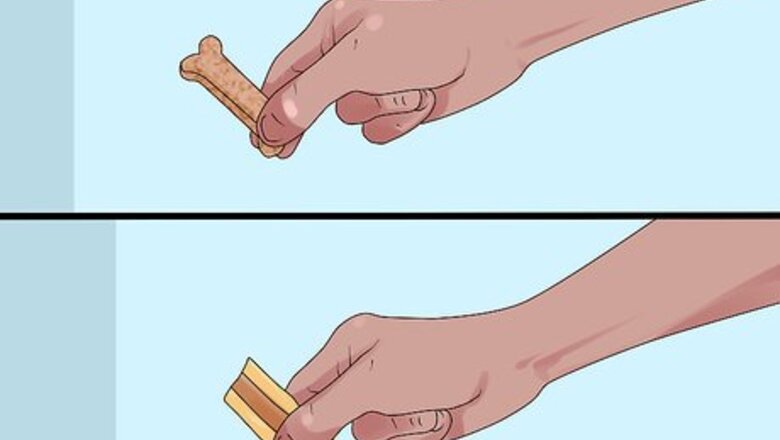
views
Training your Dog to Come

Gather some special treats for your dog. Choose treats that your dog will enjoy, but that are still healthy. You should always use treats designed for dogs, rather than small pieces of your own food. Hold the treats in your pocket or a small bag, so that they are out of sight. Choose a treat that the dog only gets when you practice training. If he or she gets the same treat at other times, it will be harder to get him to associate the treat with the desired behavior. You can break treats up into smaller pieces and your dog will still be just as excited about them.
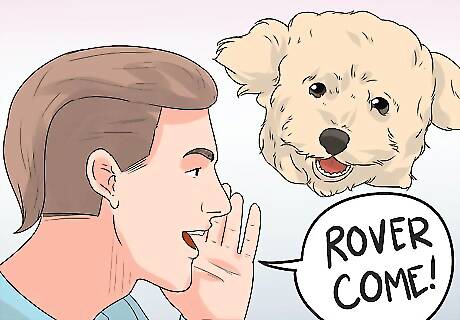
Call your dog to you while you’re in a small room together. Use a simple, verbal command, such as, “Come.” You can also use your dog’s name, as in, “Rover, come.” Say the command firmly once. Wait to see if he/she responds. If he/she doesn’t, repeat the command in the same tone. Limit distractions in the room such as other people or TV. Make sure there are no exits for your dog to escape through. This will limit the options of where he can go if he or she’s confused.
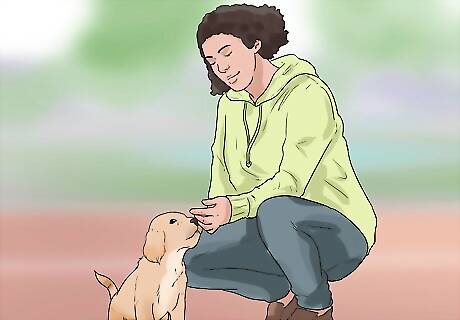
When your dog comes, give him/her a treat. If your dog comes to you, he or she’s done a very good thing. Praise him or her and pet him/her to let him/her know that you appreciate this behavior. Immediately give him/her a treat so that he'll/she’ll remember that he/she was rewarded for following directions. Pet your dog and speak to him or her lovingly when you give the treat. This is another way of rewarding him/her.
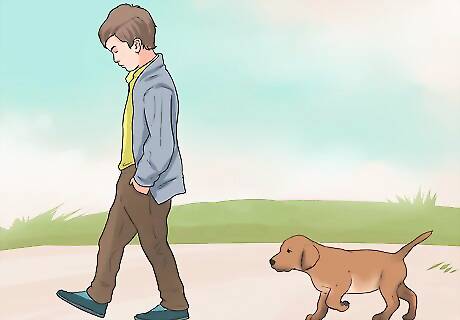
Walk away from your dog. Once you’ve given your dog a treat and praised him/her, the task is over. You can now walk away from your dog. He or she will probably follow you, especially since you just praised him. Continue to walk around until he/she gets bored or distracted and stops following you. Stay inside, or in an enclosed space. Don’t give your dog the chance to run away. If your dog takes too long to leave you alone, you can begin another activity on your own, like cooking a meal or doing some chores. Once the dog sees that you’re distracted, he’ll/she'll likely get bored him or her self.

Call your dog again. Once your dog has left you alone, try calling him or her again. Use the exact same command and tone that you did the first time.Your dog will probably be farther away now, so you may need to call louder or repeat the command multiple times. Resist the temptation to move close to your dog. Your dog may think this is a game, or he or she may begin to assume that you will always come to him.

Repeat this process until you have regular, predictable success. Practice this command several times a day until your dog will predictably come when called. Be consistent. Make the time to practice every single day. Repetition is what will train your dog to come on command. Just like people, dogs have limited attention spans. If you notice your dog getting bored or antsy, stop for the day. You can practice again tomorrow.

Practice this command in increasingly larger spaces. Once your dog reliably comes on command, start to practice in larger spaces. This can mean a larger house, or an enclosed dog run or dog park. Scale up slowly. Don’t immediately move from your bedroom to a dog park.
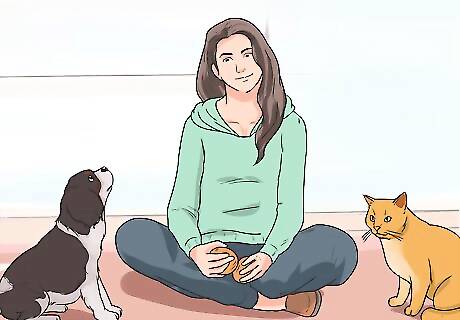
Try distracting your dog, once he or she's mastered the command. This step can be the most difficult for a dog, especially for dogs bred to hunt. Distractions can be other people, other animals, or ambient sounds. When your dog is left to roam free in your yard there will be plenty of distractions, so this is an important step for him or her to master. When using other people as a distraction start with people the dog knows. This will be less jarring for the dog than introducing a stranger. Small animals may be birds or squirrels in your yard. These wild animals can generally keep themselves safe from dogs. Don’t purposefully put a small animal (like a kitten or gerbil) in danger by introducing it to a dog.
Training your Dog to Stay
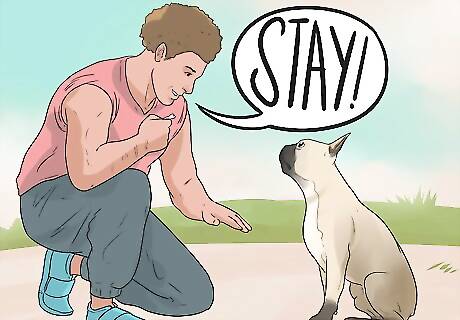
Combine a hand signal with a verbal command. “Stay” is the most common command for getting a dog to stay still. However, it’s more powerful when combined with a hand signal. An easy hand signal to remember is putting out your hand as though you’re telling someone to stop. Practice saying the command and doing the hand signal at the same time. Use a firm, clear tone of voice. Make your signal one clean motion.
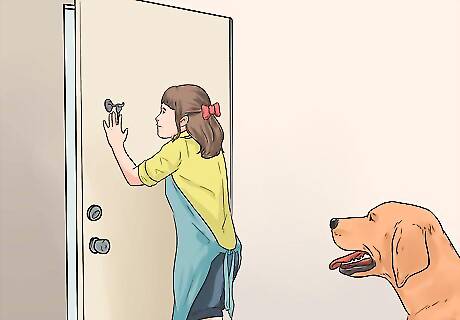
Walk toward the front door. Act natural, as though you’re about to leave the house. Do anything you would normally do, such as grabbing your keys or hat. Don’t speak to or look at your dog as you go.
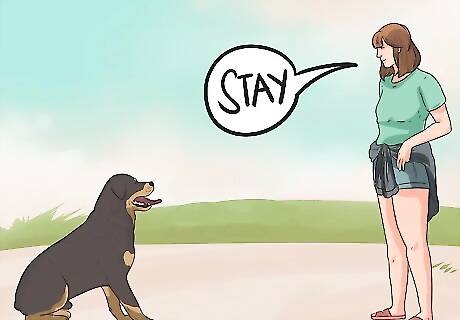
Respond if your dog follows you. Even if you’re not looking at him, you’ll likely hear him trailing behind you. As soon as you notice that he is following you, stop and turn to him. Use the same verbal command and hand signal to tell him to stay. Resist the urge to pet your dog to comfort him at this point. This will encourage him to follow you more. Use the command and hand signal only once and then turn to go again.
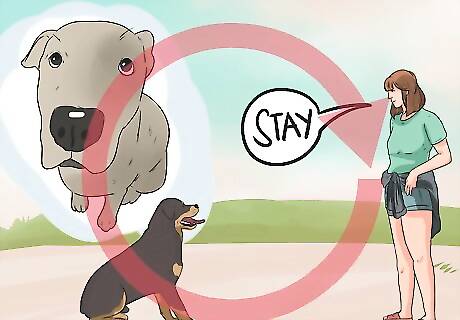
Repeat this until the dog doesn’t follow you. It may get tedious but continue to turn and repeat the command until your dog stays. You should be able to get all the way to the door without your dog moving from their “stay” position.
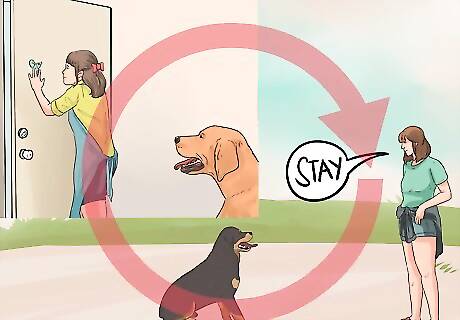
Repeat this until you can fully open the door without your dog moving. Once your dog can reliably stay until you get to the door, practice opening the door. You should be able to open the door slowly and step through it without your dog moving. Be careful when opening the door. Your dog may still get excited and try to run for it. When your dog can reliably stay, you should be able to open the door for several seconds without him running outside.
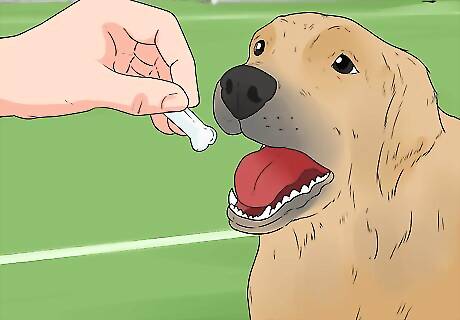
Praise your dog and give treats for good behavior. Once you’ve gone out the door and your dog has successfully stayed put, come back inside and give him a treat. You should also pet him and praise him so that he knows how good he’s been. Don’t give the treats and praise until you’re able to get all the way out the door without him following you. Keep treats hidden until you decide to give them, otherwise they can be a distraction.
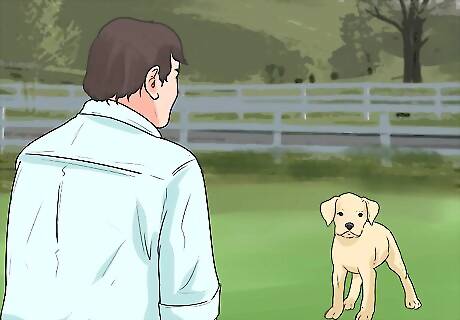
Practice "stay" outdoors. Now that your dog can reliably stay when you head for the door, you can practice outside. Begin in an enclosed area, such as a fenced yard or dog run. Use the same verbal command and hand signal that you used inside. Your dog may get distracted by animals and other people outside. This creates a challenge in getting him to stay. You may need extra practice for him to master it. Try walking away from your dog once you've told him to stay. He should be able to do this outside as well as inside. Practice in increasingly larger spaces. Eventually, your dog should be able to stay in an open yard without running off.
Removing Incentives to Run Away

Make sure your dog’s environment is familiar. Many dogs run away because they think they need to get home. If you’ve moved recently, your dog may not understand that your new home is his new home. Whenever your dog will be spending time in a new place, give him time to explore and become familiar with the smells and sounds.

Get your dog spayed or neutered. A common reason dogs run off is to find a mate. This is especially true of unneutered male dogs. Having your pet spayed or neutered will help prevent this urge. Spaying and neutering also helps prevent unwanted puppies from becoming strays and crowding shelters.
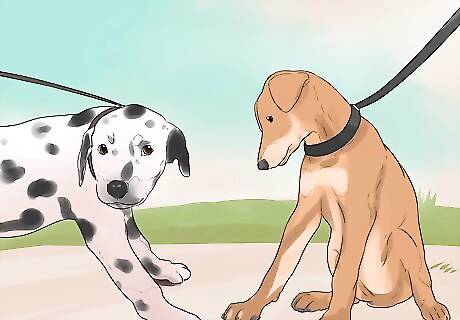
Give your dog plenty of interaction. Dogs are social animals. They need stimulation and interaction or they’ll become bored. Make sure your dog has plenty of social time with you, other dogs, or other people. If you work long hours, consider hiring a dog walker or pet sitter to engage your dog during the day. Not all dogs will get along with others. Always introduce dogs while they’re on a leash to prevent dangerous fighting.
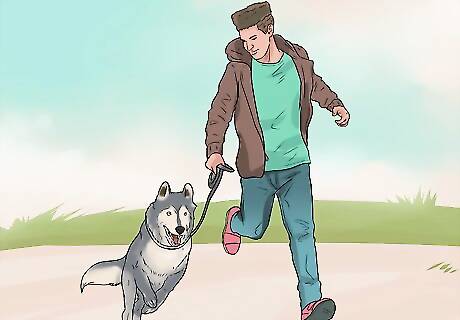
Give your dog plenty of exercise. Sometimes, dogs run off simply because they want to run. Make sure your dog gets plenty of walks and time outside. This way, he won’t need to run away just to get exercise. Different breeds need different amounts of exercise. For example, a pug may only be able to walk briskly for 20 or 30 minutes before needing a break. A husky is bred to run great distances. Find out what’s healthy for your particular breed. Exercise can include going for walks, chasing a ball or a frisbee, or running around a dog park with other dogs.
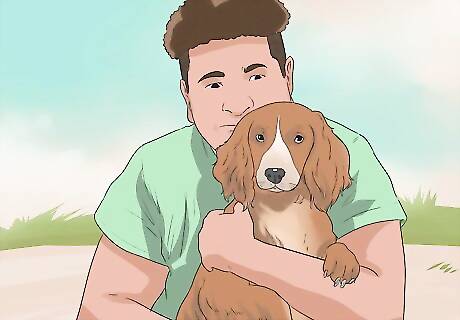
Reward your dog coming back to you. Make sure your dog knows that coming back is good behavior. When he comes back, praise him and give him a treat. This reward will teach him that coming back can feel as good as running away. Never scold a dog when he returns to you, even if it took him a long time. This teaches the dog that he’ll be punished for coming back. Don’t only call him back when the fun is over. For example, if you’re at the park, call him back for a moment before letting him continue to play. If you always call him right before going home, he’ll learn that coming back means that playtime is over.




















Comments
0 comment